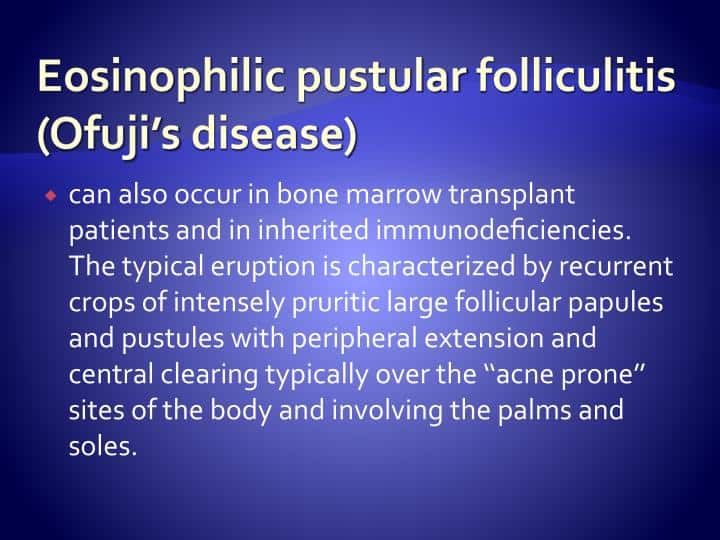BEST SKIN SPECIALIST TALKS ABOUT EOSINOPHILIC PUSTULAR FOLLICULITIS OF OFUJI IN AN IMMUNOCOMPETENT (NON-HIV) PAKISTANI PATIENT
Case Report Eosinophilic Pustular Folliculitis of Ofuji in an Immunocompetent (Non-HIV) Pakistani Patient
Prof. Dr. Ikram-Ullah Khan, Saima Rafiq Dermatology Department, Pakistan Institute of Medical Sciences, Islamabad : Eosinophilic Pustular Folliculitis Case Report
Abstract
Eosinophilic pustular folliculitis is a rare condition characterized by recurrent, pruritic papulopustules and plaques that expand peripherally. It primarily affects hair-bearing areas such as the face, chest, back, and upper arms. Although more than 90% of reported cases are from Japan, we present a case of eosinophilic pustular folliculitis in a young immunocompetent Pakistani male. Diagnosis was based on both clinical presentation and histological findings.
Introduction
Eosinophilic pustular folliculitis (EPF) is an idiopathic papulopustular follicular eruption primarily found on the upper trunk, face, neck, and proximal extremities. It can also affect palms and soles. It is more prevalent in immunocompromised individuals and those with HIV. The classic variant is most common in the second to fourth decades of life, while infantile EPF is usually congenital. While the histopathological hallmark is perifollicular eosinophilic infiltrate, the underlying pathophysiology remains unclear. Treatment options include prednisolone, dapsone, minocycline, and other agents.
Case Report
A 23-year-old man presented with erythematous pruritic plaques and pustules on his face, neck, ears, trunk, arms, and palms. The lesions started as discrete papules and pustules on his trunk, which then coalesced into plaques. Peripheral eosinophilia was noted. Skin biopsy confirmed the diagnosis of eosinophilic pustular folliculitis. The patient was treated with prednisolone and dapsone, leading to improvement within 20 days.
Discussion
Eosinophilic pustular folliculitis is characterized by its papulopustular eruption on the upper trunk and extremities. There are three variants of this disease: classic, HIV-associated, and infantile. It is more common in immunocompromised and HIV patients, with the histopathological hallmark being perifollicular eosinophilic infiltrate. Although it can be clinically mistaken for other conditions, its histology is distinctive. Treatment includes various options such as indomethacin, isotretinoin, and dapsone. Our patient showed improvement with dapsone and topical steroids.
References:
- Jaliman HD, Phelps RG, Fleischmajer R. Eosinophilic pustular folliculitis. J Am Acad Dermatol 1986; 14: 479-82.
- Ramdial PK, Morax N, Dlora NC, Aboobakar J. HIV-associated eosinophilic folliculitis. Am J Dermatopathol Acad 1999; 21: 241-6.
- Rosenthal D, Leboit P, Klumpp L, Berger T. Human immunodeficiency virus-associated eosinophilic folliculitis. Arch Dermatol 1991; 127: 206-9.
- Ofuji S, Ogino A, Horio T et al. Eosinophilic pustular folliculitis. Acta Derm Venereol 1970; 50: 195-203.
- Buezo GF, Fraga J, Abajo P et al. HIV-associated eosinophilic folliculitis and follicular mucinosis. Dermatology 1998; 197: 178-8.
- Jang KA, Chung ST, Choi JH et al. Eosinophilic pustular folliculitis. Dermatol 1998; 25: 74.
- Ellis E, Scheinfeld N. Eosinophilic pustular Folliculitis. Am J Clin Dermatol 2004; 5: 189-97.
- Ishiguro N, Shishido E, Okamoto R et al. Ofuji’s disease. J Am Acad Dermatol 2002; 46: 827-33.
- Kabashima K, Sakuri T, Miyachi Y. Treatment of eosinophilic pustular folliculitis with tacrolimus ointment. Br J Dermatol 2004; 151: 949-50.
- Teraki Y, Konohana I, Shiohara T et al. Eosinophilic pustular folliculitis [Ofuji disease]: Immunohistochemical analysis. Arch Dermatol 1993; 129: 1015.
- Wilson BD, Kucera JC, Shin PJ. The role of radiation treatment in the management of eosinophilic pustular folliculitis. J Med 2002; 33: 111-3

